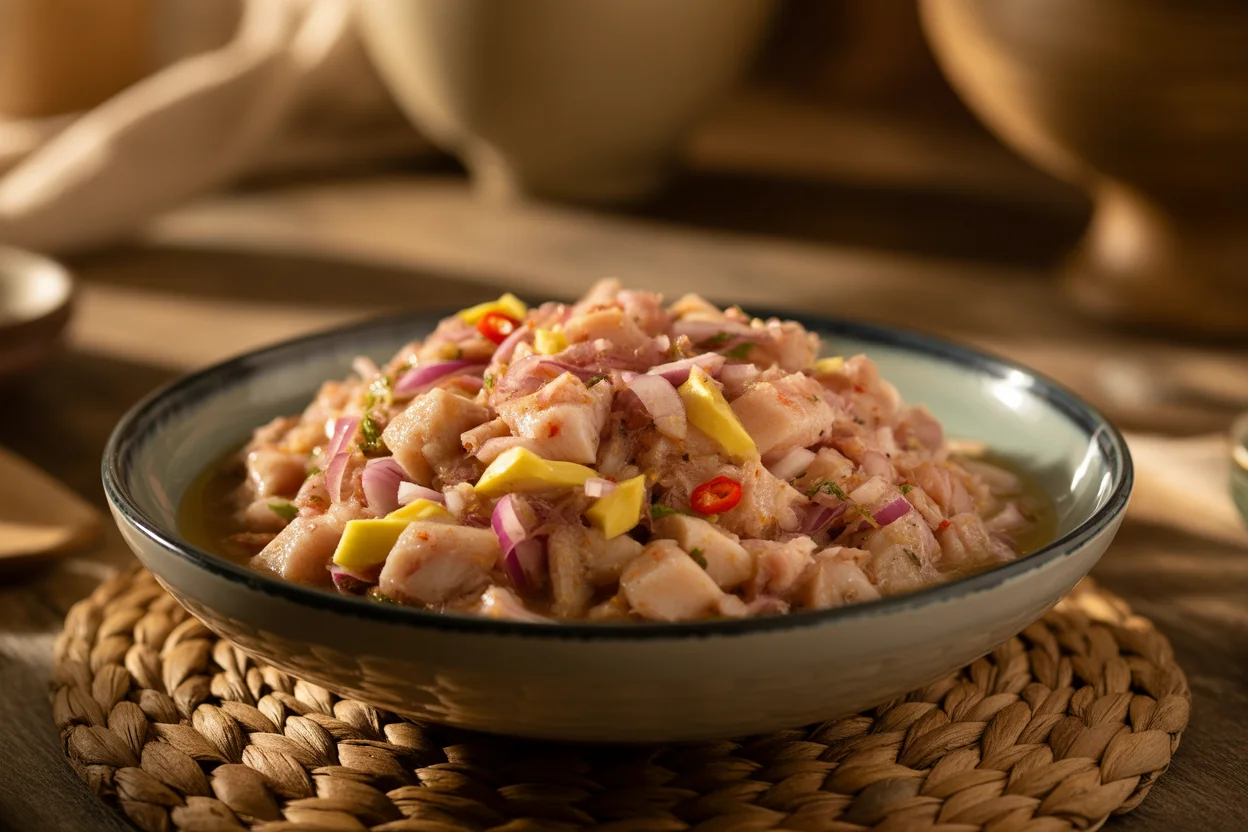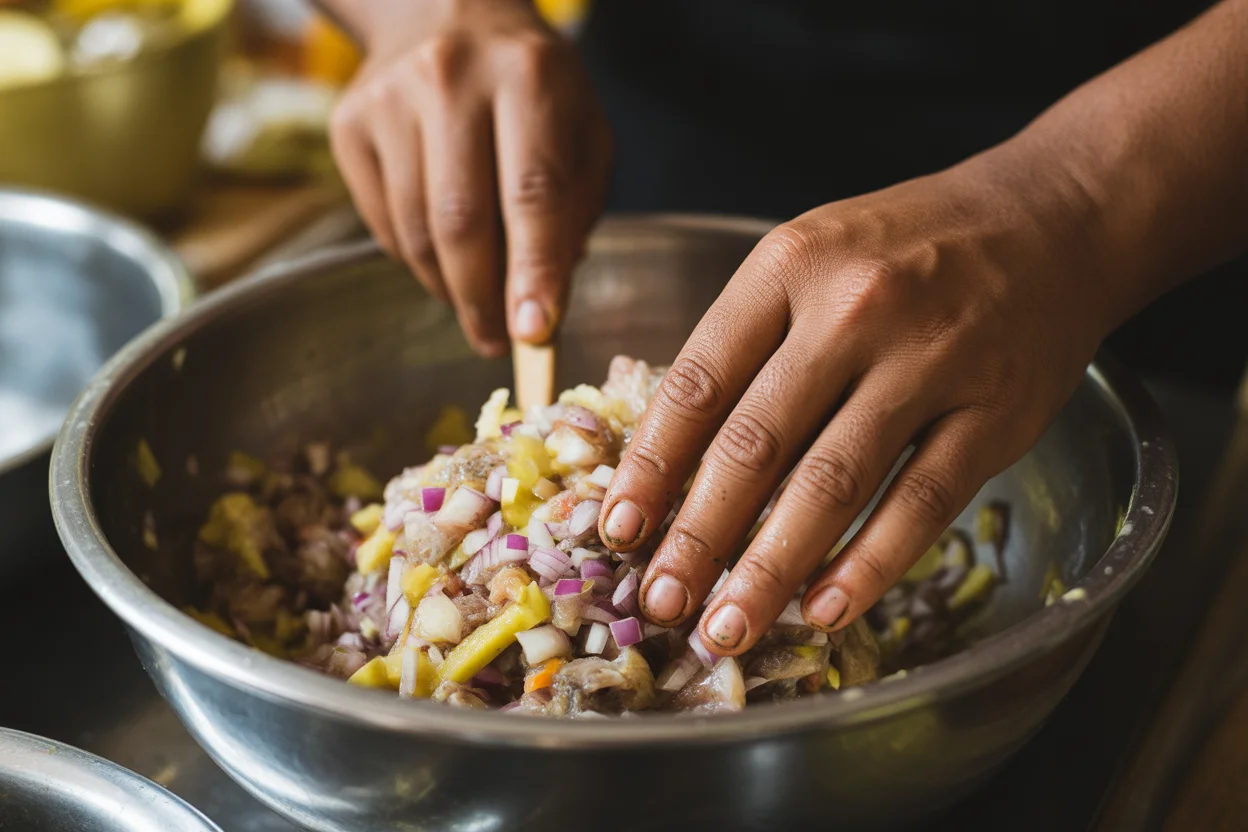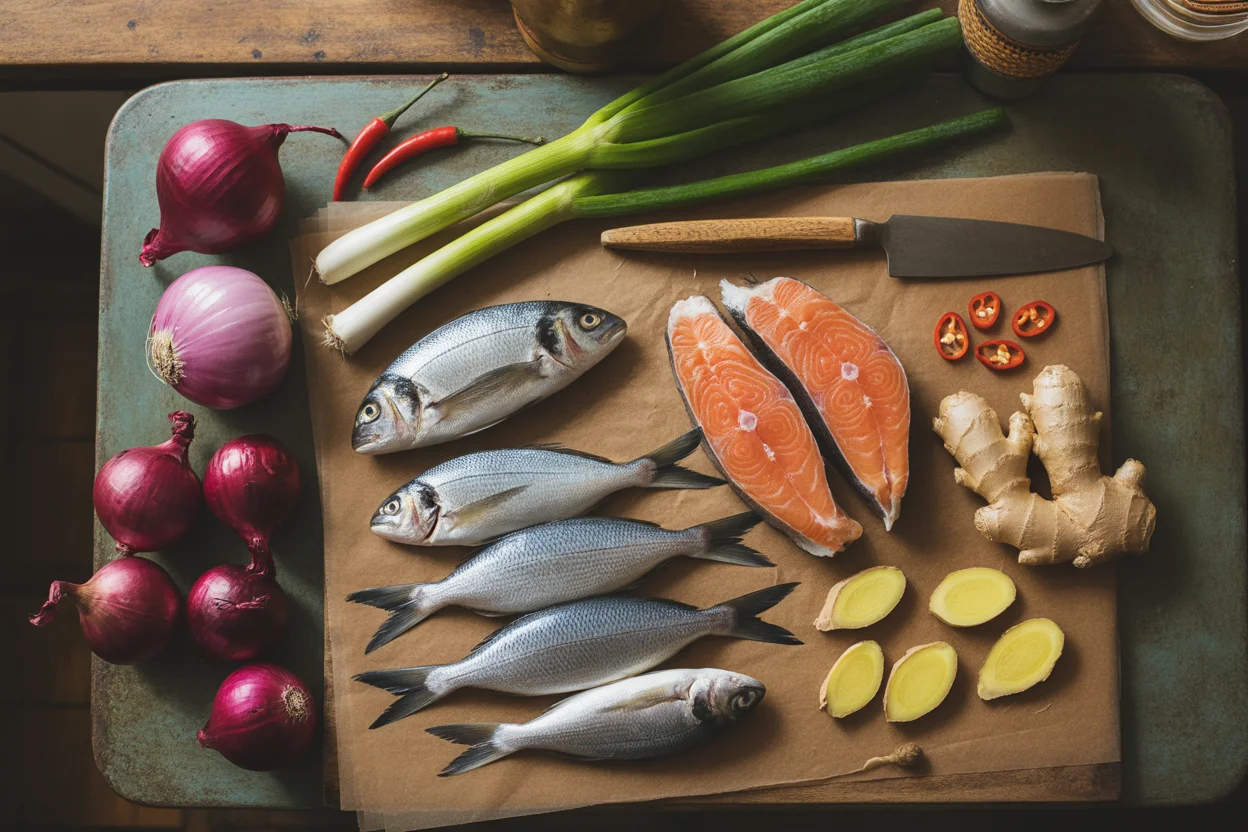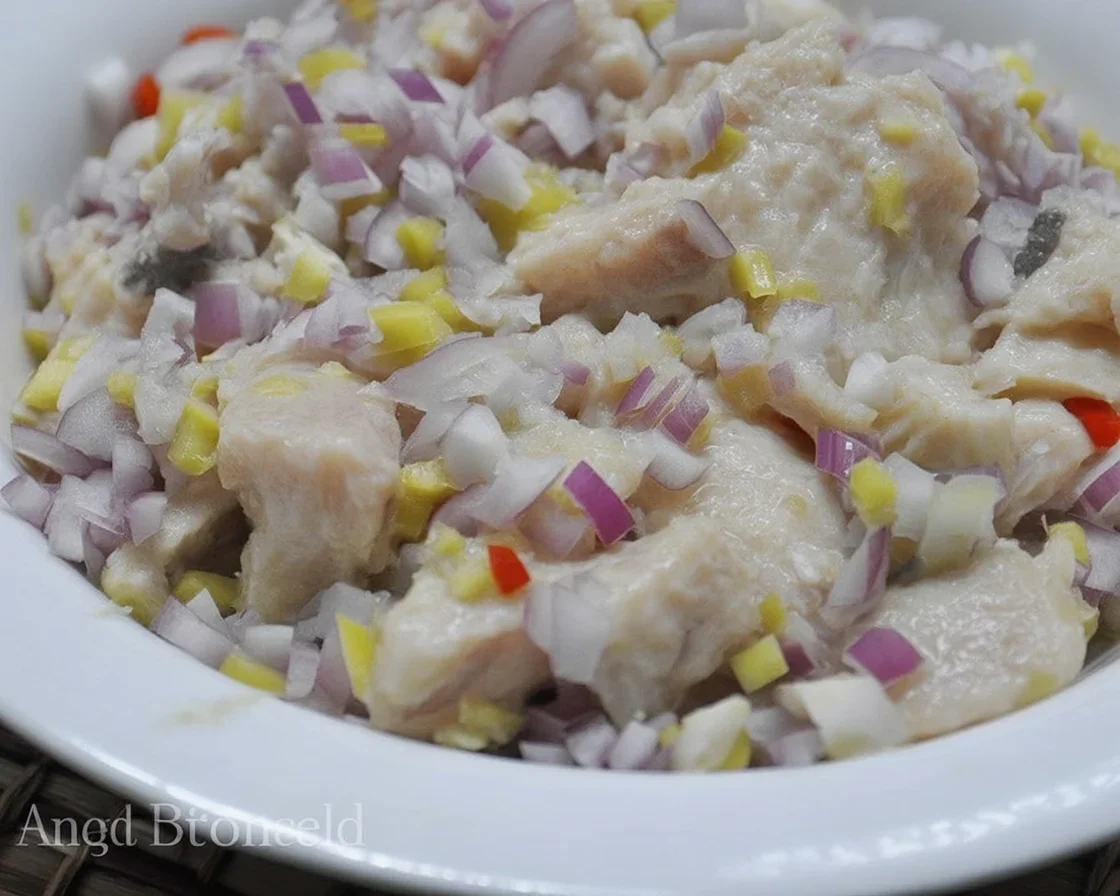Filipino kilawin na isda is probably the dish you crave when you want something bold and fresh but don’t want to cook (come on, we all have those days). That feeling when it’s hot outside and even your favorite garlic sinangag just won’t cut it? Or picnic plans, but you’re short on time—this is the hero. Sometimes I end up torn between grilled fish with dipping sauce or kilawin na isda, but honestly, this tangy Filipino ceviche almost always wins just because it’s so dang easy. Let’s get into making this beauty! 
Overview of kilawin
What is kilawin na isda, anyway? It’s the Filipino answer to ceviche—raw fish “cooked” in vinegar, tossed with fresh onions, chilies, and sometimes coconut milk. It’s bright, zingy, and wakes up your soul… unless you overdo the chili (ouch, learned that hard way). In the Philippines, kilawin na isda is a go-to dish for beach trips, family get-togethers, or even midnight snacks.
People love it ’cause it’s quick—just chop and mix. It’s also super customizable. Some folks add a dash of coconut milk for richness, others keep it sharp and citrusy. I’ve even seen versions with green mango. The backbone, though, is always ultra-fresh fish, a splash of vinegar, and a little something punchy like ginger or onions. Pair it with some cold drinks and you have what feels like a five-star restaurant snack right at home.
I tried kilawin na isda at a local eatery on a road trip—couldn’t believe how clean and fresh it tasted. Like biting into summer. I immediately had to try making it myself. Never looked back.

Choosing fresh fish
This is non-negotiable—your kilawin na isda is really only as good as your fish. Take it from me: I once made it with not-so-fresh tuna, and wow, let’s just say my dog ate better that day.
Look for fish that smells clean, almost like the ocean. No fishy funk, please. For this dish, tanigue (Spanish mackerel), tuna, or even lapu-lapu (grouper) work great. If you squeeze the flesh and it bounces back, you’re good. Eyes clear, skin shiny—don’t settle. If you don’t trust your fishmonger, find another one! Also, tell them you need fish for kilawin na isda so they know you mean business.
Worried about eating raw fish at home? Some folks freeze their fish for half a day first—kills off anything suspicious. Or buy sushi-grade, because sometimes you gotta treat yo’self, right? 
Preparing marinade
Let’s talk marinade. It’s where the magic happens. The basics: white vinegar, maybe a little calamansi juice if you can snag some, sea salt, and black pepper. Some people throw in a bit of sugar, others call that cheating (I say, do what tastes right).
Start by soaking the chopped fish in vinegar for 10-15 minutes. Not forever—just enough to “cook” the outside but keep the fish supple inside. After that, you pour off most of the vinegar and start building flavor with your aromatics.
I like to mix in ginger, chopped onions, and slices of red chili (labuyo if you’re feeling brave). Play with it! Some recipes add slices of cucumber or tomato. Oh, and don’t forget salt—taste as you go. You’re the boss in this kitchen.
Mixing ingredients
Now for the fun part—tossing everything together. You’ve got your “cooked” fish, right? Drop it in a bowl and shower on chopped onions, ginger, fresh chili, and maybe even some green mango if that’s your thing.
Stir gently. No mashing! You want those cubes intact, no mushy mystery mix here. This isn’t a stew, it’s more like a fish salad—every piece should look bright and tempting. If you want it creamier, swirl in a little coconut milk at the end (trust me, it’s awesome but not traditional everywhere).
Notice the colors? It’s like a confetti party. Don’t be shy with the chilies, unless you’ve got kids or spice-wimpy friends lurking nearby. Taste and adjust. The flavor should slap your tastebuds—zesty, a hint of heat, a whiff of onion. Give it ten more minutes to settle and get even tastier.
Serving cold
Kilawin na isda needs to be cold. Like, straight-from-the-fridge cold. There’s no room for “room temp” here (unless you’re running out of fridge space and then, well, just eat it faster).
Some serving ideas, because you’re not boring:
- Pile it on banana leaves at a picnic.
- Spoon it over steaming rice for a “raw” meets “cooked” contrast.
- Serve with crispy fried garlic bits if you’ve got time.
- Add as a top-tier pulutan with cold beer—seriously, nothing better on a hot day.
If you’re eating with beer or even a cold soda, you’re halfway to vacation mode already. Try it with shrimp ceviche for a full-on seafood fest.
Flavor tips
Alright, want to really dial up your kilawin na isda? I’ve messed this up (don’t ask), but now I swear by a few tricks.
First, don’t drown your fish in vinegar for too long. It’ll go rubbery. Or like, eating pencils. Add chopped ginger early, so the punch isn’t overwhelming. Use red onions instead of white—they’re sweeter and less clingy on your breath. If you find it too sour, a touch of coconut milk fixes everything. But keep it light or you’ll lose the fresh zing.
Oh, and if you’re curious about how kilawin stacks up against other Filipino fish dishes, check out ginataang isda for a creamy option. Totally different vibe but just as awesome.
Health benefits
So, let’s get into the health stuff, if you’re curious. Kilawin na isda is packed with lean protein, thanks to all that fish. No deep frying, no oil slicks, just all-natural ingredients (assuming you aren’t dumping sugar in, which, by the way, some folks do and it’s honestly fine).
The vinegar “cooks” the fish, so there’s less bacteria risk if the fish is really fresh. Onions and ginger help with digestion, trust me, your tummy will thank you. And, if you’re loading up with chilies, that’s a solid vitamin C bump.
This dish is naturally gluten-free, low-carb, and super light. You can eat a whole plate and not feel like a stuffed lechon. Perfect for days when you want a break from heavy stuff or when you’re trying to balance out all the grilled pork BBQ you know you’re going to have on the weekend.
Common Questions
Is it safe to eat kilawin na isda at home?
It is, as long as your fish is super fresh or sushi-grade. If in doubt, freeze it first for a few hours. Always trust your nose.
Can I use other seafood besides fish?
Absolutely. Shrimp, squid, and even scallops work. If you want a twist, check out shrimp ceviche for another great take.
How long does kilawin na isda last in the fridge?
Honestly, best eaten the day you make it. But if you have leftovers, eat them the next day—any longer and it might get too tough or overly sour.
What’s the difference between kilawin and kinilaw?
They’re super close! Some regions use the words interchangeably, others say kinilaw na isda is specifically fish, while kilawin can cover meats too.
Can I serve kilawin na isda as a main dish?
Why not? Pair it with rice or veggies, make it a light meal. Or go all out and serve with fish simmered in tomatoes and tamarind for a crazy good seafood spread.
Give it a Go: Your Turn to Try
To sum it all up, Filipino kilawin na isda marries bold flavors, crunchy veggies, and no-fuss preparation for a dish that always feels like a celebration. Just remember: fresh fish, good vinegar, and your own twist—that’s what makes it shine. If you want more ideas or need another take, I’ve found the Kinilaw na Tanigue Recipe and Kinilaw Na Isda (Fish with Vinegar and Ginger) guides helpful too.
Go on, toss together your own batch of kilawin na isda. Invite some folks over, or just hog it all—I won’t judge. So take the plunge, enjoy something zingy and new today. 
Kilawin na Isda
Ingredients
For the Kilawin
- 800 grams fresh fish (tanigue, tuna, or lapu-lapu) Choose fish that is ultra-fresh or sushi-grade.
- 1/2 cup white vinegar Used to 'cook' the fish.
- 2 tablespoons calamansi juice Optional, for additional tang.
- 1 teaspoon sea salt Adjust to taste.
- 1 teaspoon black pepper Adjust to taste.
- 1 tablespoon sugar Optional, adjust based on preference.
- 1 inch ginger (chopped) Adds flavor.
- 1 cup red onions (chopped) Sweeter flavor compared to white onions.
- 1-2 pieces fresh chili (slices) Use labuyo if you want heat.
- 1/2 cup coconut milk Optional for creaminess.
Instructions
Preparation
- Choose fresh fish and ensure it smells clean. If using frozen fish, thaw and check for freshness.
- Soak the chopped fish in vinegar for 10-15 minutes to 'cook' the exterior.
- Pour off most of the vinegar, leaving just enough for flavor.
Mixing Ingredients
- In a bowl, combine the 'cooked' fish with chopped onions, ginger, fresh chili, and optional green mango if desired.
- Gently stir the mixture, ensuring the fish cubes remain intact.
- Add coconut milk if a creamier texture is preferred and let it rest for 10 minutes for flavors to meld.
Serving
- Serve the kilawin na isda cold, straight from the fridge.
- Presentation ideas include serving on banana leaves or with crispy garlic bits.
- Enjoy as a snack with cold drinks, or over steamed rice.

